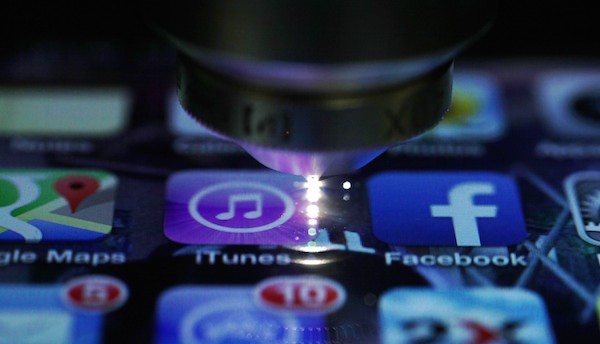
[Image credit] invisible waveguide (pathway for light) being written via laser into a smartphone’s display glass. The waveguide is a horizontal line from the left side of the screen, but it cannot be seen with the naked eye. Credit: Optics Express
Today’s technology is really good at making you need the thing that you never even knew existed.
Scientists at Corning, Inc. and Polytechnique Montreal in Canada are keeping the trend alive with the debut of a new technology that will undoubtedly put see-through sensors right into the glass of your soon-to-be-smarter smartphone.
The work, published in Optics Express, details the “first laser-written light-guiding systems that are efficient enough to be developed for commercial use,” according to a press release from The Optical Society.
Using femtosecond lasers, the scientists created photonic waveguides—channels for light to travel within—in Corning’s Gorilla Glass, creating a photonic system that can replace more traditional, and constraining, electronic systems. Because Gorilla Glass is already in place of billions of electronic devices, the new tech signals big changes in how we use and interact with our world.
The research demonstrates the first high-quality photonic waveguides carved into the tough glass. The laser-etched guides are 10 times better at minimizing light loss from imperfections in the glass than previous attempts, according to the press release.
As if the fact that the waveguides are better—which means increased functionality and reduced energy use—wasn’t enough, using a laser makes the process simple, quick, cheap, and flexible.
“Using lasers enables researchers to make waveguides at any depth, allowing them to create many applications, one on top of each other, like layers in a cake. Layering the waveguides within the glass itself paves the way for more compact devices, which means you could squeeze more apps into your phone,” according to the release.
The team has already demonstrated that they can create a waveguide sensor that can take your temperature or that of anything it touches. They also successfully created a waveguide-based authentication process that will create an entirely unique identity for your most treasured device.
The press release explains, “The researchers also developed a new method for authenticating a smartphone based on waveguides with holes at various locations. The light that escapes through those holes creates a pattern that is unique to their arrangement. The idea is that each phone would have its own unique pattern, like a fingerprint, which could then be read by an infrared detector to confirm the identity of the phone as an additional layer of security for making financial transactions using smartphones.”
Beyond smarter smartphones, the tech could eventually lead to the integration of computing devices and sensors into other glass surfaces, like tables and windows. It seems that Corning was alluding to more than wishful thinking in their popular YouTube video below.
“We’re opening the Pandora’s box at the moment,” co-author Raman Kashyap, an engineering professor at Polytechnique Montreal, says in the press release. “Now that the technique is viable, ‘it’s up to people to invent new uses’ for it.”
The open-access paper is “Making smart phones smarter with photonics” (DOI: 10.1364/OE.22.015473).
Credit: Corning Incorporated; YouTube

